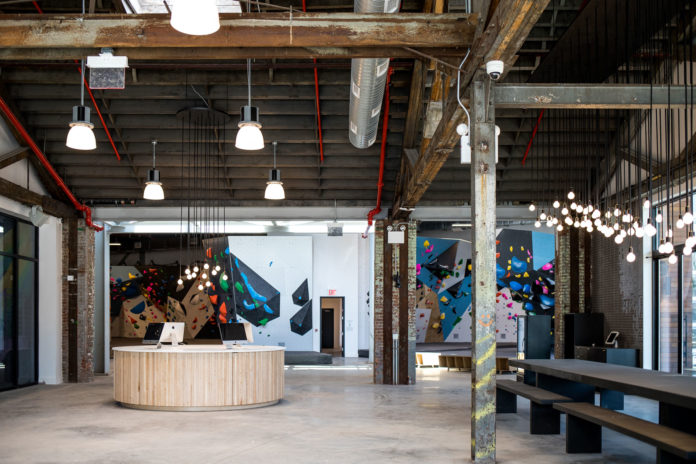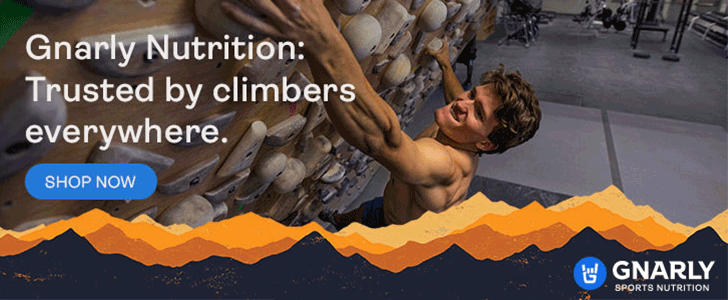Behind the Desk is a series that interviews people who are part of the climbing industry—those who manage staff, create innovative products, and own gyms. Today we’re chatting with David Sacher, who co-founded (along with Nam Phan) VITAL Brooklyn. The 45,000-square-foot, bouldering-focused gym in the Williamsburg neighborhood opened in May—thus marking the VITAL brand’s first venture to the East Coast. The facility’s backstory is fascinating: a historic 1910-era metalware warehouse destroyed by a fire and now given new life as a climbing gym in one of New York City’s most vibrant areas. But just as fascinating is the methodology behind the new gym and its operations, where VITAL is taking its 24-hour gym access model coast-to-coast. We couldn’t wait to learn more directly from Sacher.
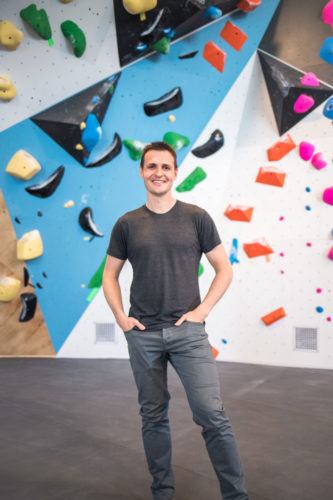
CBJ: I suppose a good starting point is: How have things been going since the new [Brooklyn] gym opened?
SACHER: It’s been awesome—incredible. We have four gyms on the West Coast and we kind of have our finger on the pulse of how gyms are doing during COVID, and it’s—at least in the markets we’re in—a recovery. Not immediate, but things are slowly—step-by-step—making their way back to normal. But you would never know that with our Williamsburg gym—it has opened and it has felt like there’s no resistance and nothing holding it back. It’s busy, it’s full, it’s happy—it feels like, other than the face masks, almost like we’re opening at any other time. So, it has been great.
You mentioned the VITAL gyms on the West Coast. Can you divulge a little about your decision to head to the East Coast with this new Williamsburg (Brooklyn) gym?
After we opened our gym in Oceanside, California, we were traveling around to markets all around the country, visiting different places. New York City—and Brooklyn, in particular—was just such a fun and interesting, vibrant area. Brooklyn—as well as the area we’re in near the waterfront—has all of these industrial buildings, and those are mixed in with a really young and creative culture that’s often using and readapting those industrial spaces into restaurants, cafes, and creative workshops. And so, as soon as we were here touring around the neighborhood, it was pretty obvious that it was going to be a really good place for us.
One of our philosophies, or approaches as a business, is that we try to be centrally located within a community. Climbing gyms have become community centers and we’re there to serve the community. Being centrally located within a community we found is a really positive thing to try and do. And here in Brooklyn is a unique place because a large industrial building that can house a gym isn’t located out by the freeway; it’s located right in the thick of it where everybody is eating and playing, working and living. So, it was a perfect fit for us.
How does all that compare to some other areas where VITAL is located on the West Coast?
New York is an interesting area because there certainly are a lot of people who are from here, and folks who are from Brooklyn. But I think maybe most of the time the people you meet are from somewhere else. The reason that’s interesting and fun is because all the people who are here have chosen to be here because they want to be here. Everyone you connect with kind of has this excitement and interest in investing in—and becoming part of—the life and the story here. You meet people from all over the world every day—all different kinds of people—and everybody, just by virtue of being here, has signed on to the same mission of creating an interesting and exciting life here. That makes it really easy to do unique and creative and fun things—because that’s just the culture of the area.
The other areas we have gyms, we also love—they’re incredible areas. But there is something magic in its own way about New York City, and the spot we’re in—in Brooklyn—is a really concentrated point of that energy.
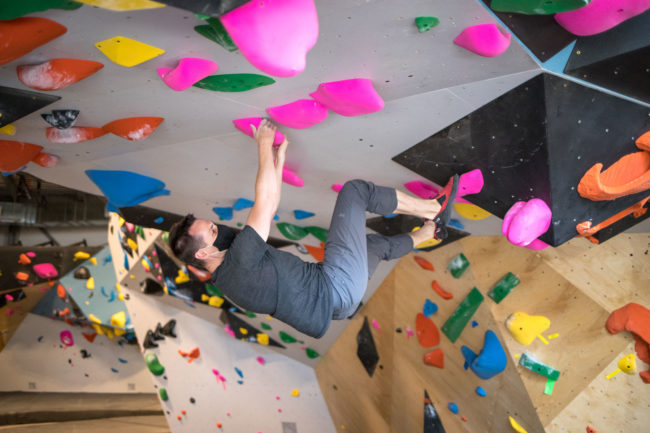
In terms of climbing gyms being veritable ‘community centers,’ what does that mean for VITAL, specifically?
The community center aspect means a lot of things. It starts with the fact that—if you build a great gym—that’s where the neighborhood wants to be. And so, people will just start to structure a significant part of their lives around the gym; they’ll do that automatically on their own. Their friends will be there, they’ll spend time there, they’ll do their work or homework there; they’ll go there many times in a week. As a gym owner, we recognize this is what people want—this is where people are finding meaningful relationships. So, let’s realize that’s the case and really lean into it. In our case, that has meant a whole bunch of different things—diversifying what we offer, so it’s not just folks who are interested in climbing that want to be there. If people are interested in aerial, or interested in cycling, or just want to go to the gym, we have areas for that. That broadens the appeal. We also want to make the space just really nice. So, our gym here has really great design…some members have a studio, and they built all the interior. There are a lot of worktables. We have a restaurant on the roof. We have a rooftop hangout area with a fire pit.
In our particular case, we also make the gym open 24 hours. We kind of want it to really feel like it’s your gym. We have stuff available on the honor system—like shoe rentals, and food available from a grab-and-go snack station. You can even bring your own guests after-hours on the honor system. So, making the gym available for folks 24 hours per day, it’s like we built this gym and we keep it clean, but it’s your space. Come in, use it, hopefully take care of it, and share it with your friends. That creates a way to invest in that community center aspect.
One other thing I should mention is we set aside scholarship funds every month for folks in the neighborhood who wouldn’t otherwise be able to afford it. If there are financial constraints you have for accessing the gym, you can get support for everything from membership to teams to competitions.
The honor system stuff—as well as 24-hour access, a topic CBJ covered back in 2015—is interesting to me. Do you ever worry about people being dishonest or taking advantage of that?
There are a lot of ways that people could take advantage of VITAL, as members. They could violate and bend and break our rules; they could get shoe rentals without paying for them, or take snacks from the fridge quite easily without paying for them. Sneak in their guests after-hours. Graffiti on the walls—whatever they wanted to do. VITAL has a situation where we are putting a lot of trust into our members and our community, to a level where people—when they first sign up as members—sometimes they raise an eyebrow, like, ‘Is this really the way it is?’ But it is—and the reason we do all that, even though you might get some people who don’t pay for a shoe rental…we try to create a culture that is really open and trusting and supportive, and I think trying to pursue perfect enforcement starts to corrode something that’s more important and that is deeper and has more value…both soft value for the community and plain financial value as well, as people want to invest in a business where they feel comfortable. So, I don’t think pursuing perfect enforcement or changing a big policy of the gym in order to eliminate one or two or three cheaters—I think the cost of pursuing that perfect enforcement becomes much higher than the cost of letting the folks who aren’t behaving honorably do that.
We provide a canvas where people can be themselves and connect with the community in a positive way, and it really does make a big impact in how people connect with the gym when they see that they are being respected and trusted as individuals—as opposed to controlled and directed and not provided with any trust or responsibility. That’s kind of our philosophy on it. All that to say that maybe, yeah, people might take advantage of it—but trying to set up a structure where it’s impossible for people to step outside the lines at all makes for a less enjoyable end result.
Since a lot of other gym/industry people will read this, how does the 24-hour access work for VITAL now, in terms of safety and risks and whatnot?
Just to be clear, the Brooklyn gym is staffed 24 hours. It’s the only gym of ours that is staffed 24 hours, and the reason for that is that it’s just such a large gym that we can afford the overnight staffing. But the after-hours staff…it’s not like it is during public hours. The front door is locked, everything is self-serve, only members can come in (and bring guests) and help themselves. The staff/crew is there almost like a night-watch, just to make sure nothing goes wrong, nobody gets hurt, that sort of thing. But it operates as though it were unstaffed.
All of our West Coast gyms are unstaffed after-hours, and you do have to put some measures in place. It comes down to the way you design it at the beginning—how you design your desk, how you design your storage area. Make sure everything is set up in a way that doesn’t require staff to be there or put things away. And you also have policies and security cameras and when you sign up a new member, you have to train them on how to do the 24-hour access. At all of our gyms, we do have volunteers who come in to check on the gym periodically throughout the night. We call them “watchdogs.’ So, there are a bunch of things we do, but if you were to walk into any one of our gyms at night, you would just unlock the door with your member card and the gym is yours. It feels very unusual for people at first when they walk in. Am I really allowed to be in here and turn on the lights and put on my own music? You totally are. 11 years in, it’s still going great.
Do a fair amount of people actually show up to climb at, say, 3:00 am?
The gym is not very crowded late at night. But I would say 100-percent of people who sign up for a membership at least like to know that if they did ever want to go there at night, they could. That’s a really encouraging thing for people to know—the gym will never go away, it will always be there for them.
A lot of people do try it out, or maybe they have a night where they’re not sleeping and want to go to the gym. It’s well worthwhile—even if you were to go to the gym at 3:00 in the morning and see only one person there…to see one person would be to underestimate the value it has for all the members because I think everyone—even if they don’t use it [at night]—appreciates it.
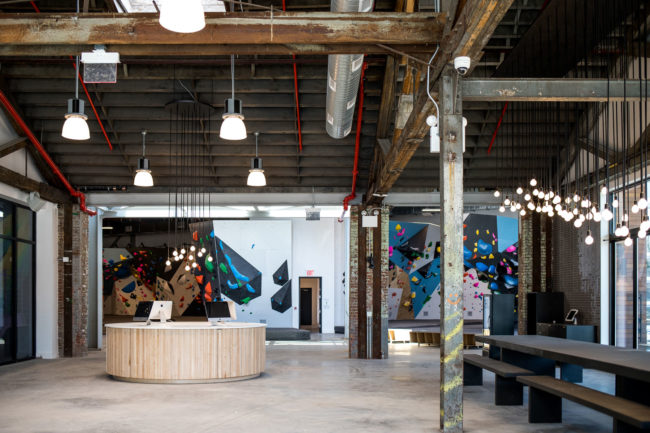
As someone who sometimes does find myself awake and unable to sleep in the middle of the night, I certainly admire the 24-hour-access business model.
It’s a lot more work to do it that way. It’s hard to do anything at the gym because you’re never closed. When we opened our first gym—in Carlsbad, California—my business partner and I slept on the sofas in the entryway for the first couple of weeks because we didn’t have any idea what would happen. But eventually we gave the gym more and more space—and it’s been many years now and we really haven’t had any issues at all.
Finally, back to Brooklyn, specifically—this gym is a little different than the other West Coast VITAL gyms, in that it is not in the same boutique-style. This Brooklyn gym is much bigger, grander. Can you speak to the decision to go big?
A big gym made sense here [in New York City]. It’s a big city and there are a lot of people here. We still very much followed the same philosophy that we used with all the other gyms. This is still very much a VITAL—it feels like a VITAL, it operates like a VITAL; it’s just a lot bigger. It’s got more stuff in it. All of our other gyms are doing great, but we always wished we had more space. So, in New York, it made sense to do what we knew worked well—in terms of how we designed the gym and how we made people feel—but just make it bigger and give people more stuff.

John Burgman is the author of High Drama, a book that chronicles the history of American competition climbing. He is a Fulbright journalism grant recipient and a former magazine editor. He holds a master’s degree from New York University and bachelor’s degree from Miami University. In addition to writing, he coaches a youth bouldering team. Follow him on Twitter @John_Burgman and Instagram @jbclimbs. Read our interview Meet John Burgman, U.S. Comp Climbing’s Top Journalist.




